Has your lawn mower ever failed to start after a long, cold winter? The frustration of dealing with a stubborn, non-functioning mower can be overwhelming, especially when the grass is growing rapidly and time is of the essence.
To avoid the hassle and expense of unexpected repairs, it’s crucial to winterize your lawn mower before the cold weather sets in. In this guide, I’ll walk you through the essential steps to winterize your lawn mower, ensuring it remains in prime condition and ready to tackle your lawn when spring arrives.
Table of Contents
To winterize your lawn mower, first remove the battery and clean the mower thoroughly. Disconnect the spark plug, drain or stabilize the fuel, and change the oil. Then, clean the undercarriage, replace or clean the air filter, check and replace the spark plug, sharpen or replace the mower blade, and store the mower properly in a cool, dry location. If you want a detailed insight on each step, read further!
Why Do You Need to Winterize the Lawn Mower?
Preparing lawnmowers for winter is important to have them in good condition when the weather is cold. Doing so will help you keep your expensive gardening machinery in shape and have it ready for use in the spring season.
Here are some reasons why it is necessary to winterize your lawn mower:
- When you prepare a lawn mower for winter, it can extend its fuel tank’s overall efficiency.
- Another benefit of winterizing your lawn mower is preventing rust and corrosion. Winterizing removes moisture build-up in the metallic parts to avoid corrosion until you use your gear the next time.
- Lawnmowers can be expensive, and I am sure nobody wants to purchase them occasionally. But if you know how to winterize a lawn mower, you won’t have to invest heavily in them frequently.
However, due to your super hectic schedule, you end up not winterizing your lawn mower, then get ready to face the below consequences.
- Leaving fuel in the lawn mower’s for a long time will create a sticky deposit inside the system, clogging the carburetor and causing irreversible damage to the engine.
- Additionally, condensation builds up inside the engine for an extended period of time and can cause damage to the cylinder or valve sticking. This will also lead to expensive and frequent repairs in the longer run.
- Another con of not winterizing your lawn mower is that you will need help starting it the next time you mow your lawn.
Now, you must be wondering how to save your lawn mower from getting damaged. If that is so, carry on reading as below. I have written a full-fledged guide on how to winterize a lawn mower the easy way. So, without further ado, let’s dive into these steps one by one.
Also Read: Best Electric Lawn Mowers for Your Garden
Step 1: Remove the Battery
The first and foremost step in winterizing the lawn mower was removing the battery. As soon as I had the battery out, I cleaned off dirt and grease using a soft microfiber cloth.
Afterward, I stored the battery in a cool and safe location. Remember to never keep batteries near flammable things like chimneys or water heaters at your home. Also, avoid using liquid solutions with the battery, which can cause short circuits.
Step 2: Clean Your Lawn Mower
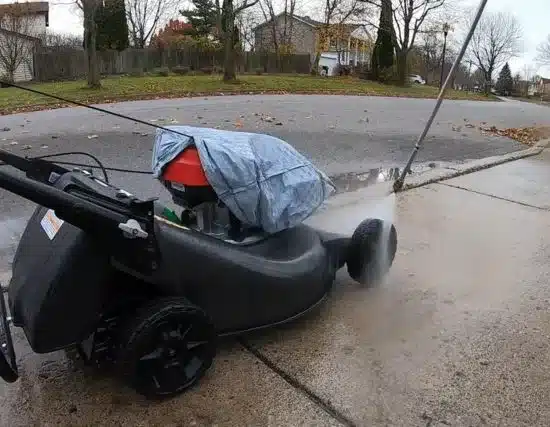
After removing the battery, I started cleaning the lawn mower. So, I began removing the stuck grass clippings and debris on the lawn mower. I sometimes use a medium-sized brush to remove the dead leaves from the mower deck and the area surrounding the engine and I also use pressure washer to deal clean the mower.
Also Read: Are Zero Turn Mowers Dangerous?
Step 3: Disconnect the Spark Plug
Now comes the most important part: disconnecting the spark plugs. If you forget to remove the spark plugs, the mower might kick start accidentally.
So, first, I had to locate the spark plugs that, in my case, were at the front of the engine. I carefully removed the spark plugs and used an oil spray to lubricate the cylinder. Pull the recoil handle several times to distribute the oil for better results evenly.
Also read: Are Zero Turn Mowers good on hills?
Step 4: Drain or Stabilize the Fuel
There can be two possibilities here: either you have a fuel preservative in your tank, or you don’t.
Suppose you have a fuel preservative in your mower’s fuel tank; you can leave the fuel unattended until next spring. However, if you haven’t used fuel preservatives, you must eliminate the gasoline from the tank.

To stabilize the fuel, I added a fuel stabilizer into the tank and powered it to distribute it through the system. I then turned off the mower and took extra gasoline into a clean can. To prepare your lawn mower for winter, run it until it no longer starts.
Step 5: Change the Oil
Clean oil plays a crucial role in ensuring the longevity of your lawn mower’s engine. Over time, dirt and debris can accumulate in the oil, causing it to become contaminated and less effective. Regularly changing the oil in your lawn mower helps to keep the engine running smoothly and can extend its lifespan.
I removed the oil reservoir plug to change the lawn mower’s oil reservoir. To remain safe, I had a tarp below the mower to escape oil splashes. I placed the mower on its side so that its air filter and carburetor were facing up. This way, I had fewer chances of spilling oil and making a huge mess.
In a pan, I drained all the used oil from the mower by tilting it into a pan. When the oil was drained, I replaced the plug.
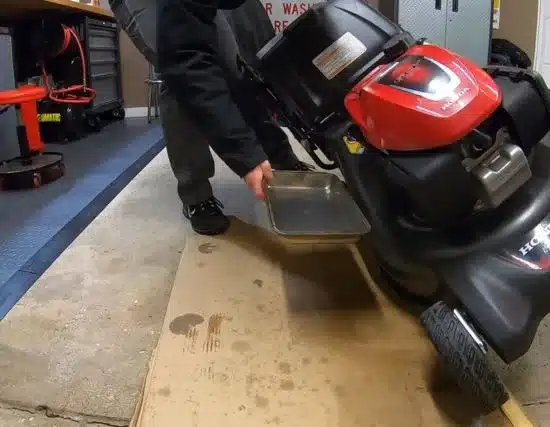
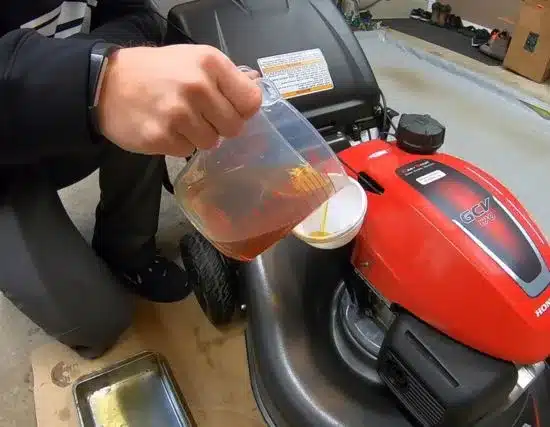
TIP: Used oil should never be dumped down the drain, onto the ground, or into the trash. Instead, it should be taken to a local recycling center or automotive service shop that accepts used oil for proper disposal.
Also Read: How long do zero-turn mowers last?
Step 6: Clean the Undercarriage
To winterize your lawn mower, you must clean its undercarriage. Here’s how to clean it:
First, I ensured the mower was turned off and the engine cooled. Next, I cleaned the undercarriage, which had a lot of debris. You can use a mild scraper to brush off all the junk. To have it cleaned quickly, use a pressure washer as I did.
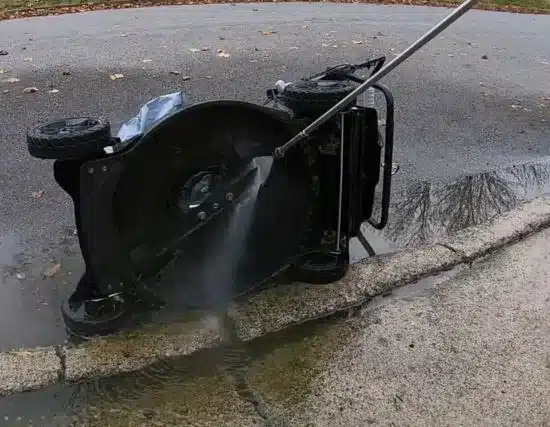
However, if you notice any stubborn debris or caked-on grass that the hose won’t take care of, grab a scraper or putty knife to help remove it. Take your time and be gentle so you don’t damage the undercarriage.
If you winterize your lawn mower without cleaning the undercarriage area, dirt can permanently damage the blades and belts. When you clean your mower, it is less likely to develop corrosion, rust, and other issues.
Step 7: Replace or Clean the Air Filter
Cleaning or replacing your lawn mower’s air filter is essential in winterizing your lawn mower. A clean air filter helps your lawn mower run more efficiently by allowing it to breathe properly. If the air filter is dirty or clogged, the engine can’t get the air it needs to run and may not start.
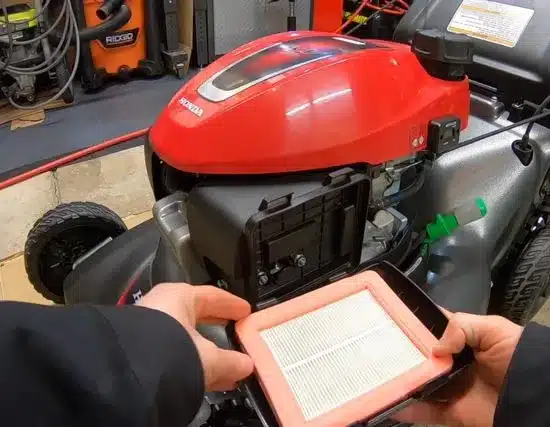

I located the lawn mower’s air filter by consulting the manual’s guide; you can do the same. I clean the air filter but you can also remove the old filter paper with a new one with paper edges facing outward. If your lawn mower has an oil-soaked sponge filter, take it out and wash it with soap, and when it is dried off, completely put it back in the mower.
Also Read: 7 best small zero turn mowers for your garden
Step 8: Check and Replace the Spark Plug
A spark plug plays a crucial role in igniting the fuel-air mixture in the engine, which powers the mower’s cutting blades. If the spark plug is not functioning correctly, it can cause the engine to misfire or not start, resulting in costly repairs. That’s why checking and replacing the spark plug is essential for winterizing lawnmowers.
To check the spark plug, I first disconnected the wire and removed the plug from the engine using a wrench. I always suggest using a specialized spark plug socket wrench with a neoprene lining to protect the plug’s sensitive casing. Then, I visually inspected the plug for signs of wear or damage, such as cracks or corrosion.
When replacing the spark plug, I ensured that I used the correct type and size of plug recommended by the manufacturer. I carefully threaded the new plug into the engine by hand to avoid cross-threading it. Ultimately, I reconnected the spark plug wire to prepare the lawn mower for the winter season.
Step 9: Sharpen or Replace the Mower Blade
A sharp mower blade is crucial for a healthy lawn as a dull blade can tear and shred grass instead of cleanly cutting it, leading to brown tips and disease-prone grass. That’s why sharpening or replacing the mower blade is a significant step in winterizing lawn mowers.
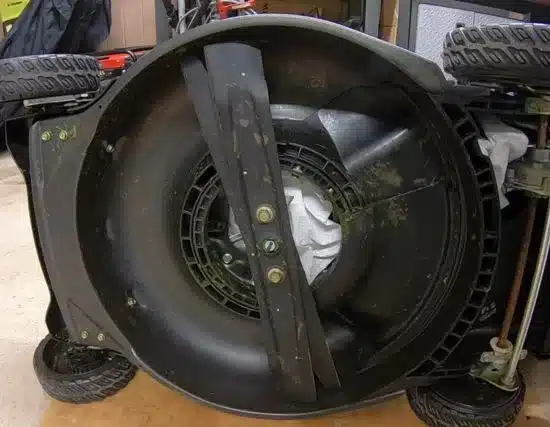
I first disconnected the spark plug wire to sharpen the mower blade to ensure it won’t accidentally start while working on it. Then, I removed the blade from the mower and sharpened the blade. I also checked the blade’s balance by hanging it from a nail and ensuring it stayed balanced.

If the blade is excessively worn, bent, or damaged, I consider replacing it instead of sharpening it. A damaged blade can lead to safety hazards and poor cutting performance. Check the blade for signs of wear, such as cracks or chips, before deciding whether to sharpen or replace it. If you want to read the detailed guide about it, here’s how to sharpen your mower blade explained step by step.
Step 10: Store Your Lawn Mower Properly
Storing your lawn mower is the final and important step to preparing lawn mowers for the winter season. I began with choosing the right location. I relied on a dry and cool place with no direct sunlight or rain. As my garage fulfilled all these conditions, I stored my lawn mower there.

Using a lawn mower cover protects your lawn mower from dust, dirt, and moisture. Before covering your lawn mower, ensure it is clean and dry. You can also apply a rust inhibitor spray to the metal parts of your lawn mower to prevent rust and corrosion.
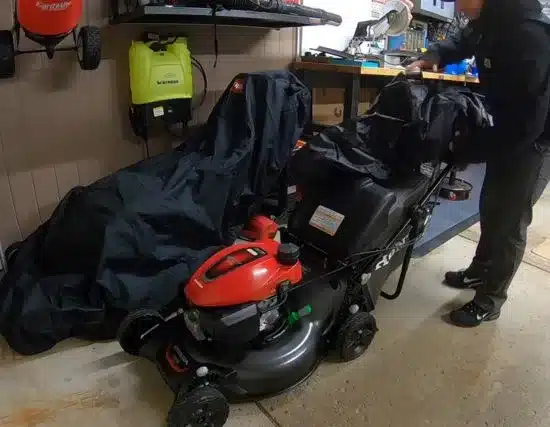
Once I am done winterizing my lawn mower, I take a few additional precautions to prevent damage during storage. Firstly, I remove the battery and store it in a cool, dry place. Batteries can lose charge over time, and extreme temperatures can cause them to degrade, so keeping them in a stable environment is essential.
Also Read: Which Is The Best Pull Behind Tiller For Lawn Mower?
Conclusion
Hopefully, my 10-step guide on winterizing a lawn mower has taught you the easiest way to winterize your lawn mower. To prepare a lawn mower for winter, you have to:
- Remove the batteries first
- Clean the lawn mower and remove the spark plugs
- Stabilize the fuel and then change the oil
- Clear out the undercarriage area and clean or replace the air filter and spark plugs
- Lastly, sharpen or replace the blades as required and winterize your lawn mower by storing it safely.
Regular maintenance will help you to avoid costly repairs and extend the lifespan of your lawn mower. If you do not winterize a lawn mower, the blades, and the machinery might corrode due to moisture build-up inside. By taking the time to winterize your lawn mower and storing it properly, you can ensure that it’s ready to use when you need it.
Frequently Asked Questions
How Often Should I Winterize My Lawn Mower?
You should winterize your lawn mower at the end of the mowing season before storing it for the winter season. You can run maintenance tasks like changing the oil, replacing the air filter, and cleaning the mower thoroughly.
Can I Use My Lawn Mower During the Winter?
No, it is not advisable to use a lawn mower during winter. A lawn mower is not designed for use in snow that often comes with winter conditions. Using a lawn mower in the winter can be dangerous and cause damage to the machine.
What if I Don’t Have a Garage or Shed for Storage?
If you don’t have a garage or shed for storing lawnmowers, you can use a sturdy lawn mower cover to protect it from external elements. Additionally, a good-quality tarp works well.
Should I Run My Lawn Mower Out of Gas for Winter?
Yes, you must run your lawn mower out of gas for winter. If any amount of fuel is left in the tank, it can propose a fire hazard. You can also add a fuel stabilizer so the gasoline inside the tank doesn’t damage the engine.
I Forgot to Winterize Lawn Mower. What to Do Now?
If you forget to winterize the lawn mower that is malfunctioning, clean the fuel tank, add fresh, stabilized fuel, and remove residue from the air filter and carburetor. Fix any faulty spark plugs and clean the mower vent. For future winters, use a fuel stabilizer.
- Best Brush Cutter: Top 5 Models for Lawn Maintenance in 2024 - January 10, 2024
- Protecting Your Garden from Rodent Damage: Tips and Tricks - December 14, 2023
- Small Space Gardening: Transform Your Garden with Raised Beds - December 10, 2023
